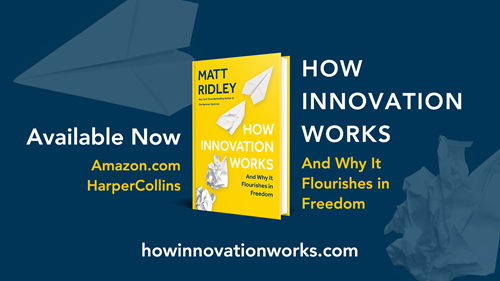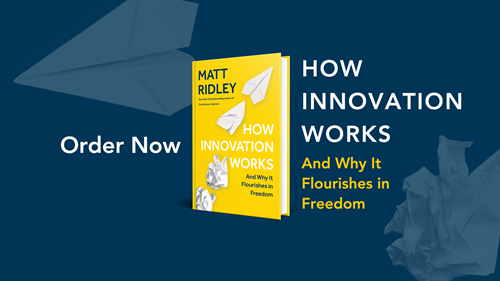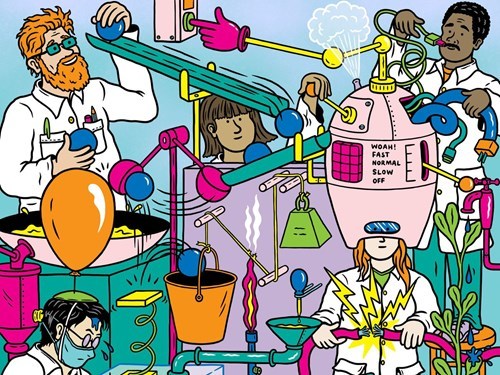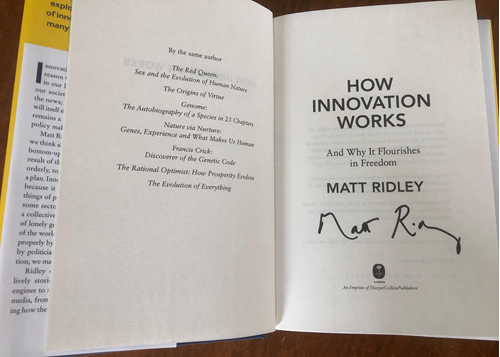Matt Ridley's Blog, page 9
June 6, 2020
My Live YouTube Q&A with Yaron Brook
In a few minutes, I will be returning to The Yaron Brook Show for another interview. A lot has happened in the 2.5 months since my last visit, so I am sure we will have a lot to discuss. We will be discussing not just innovation and the pandemic but other recent news, and anything you wish to ask about.
If you haven't been able to get your question answered at any of my talks in recent weeks, this would be a good chance to, as Yaron hosts a Q&A-based show and we'll be taking questions on YouTube in real time!
Please join us, and please be sure to watch it here after if you miss it.
Update: Here's the video.
To stay updated, follow me on Twitter @mattwridley and Facebook, or subscribe to my new newsletter!
My new book How Innovation Works is available now in the US and Canada, and available to pre-order in the UK.
May 31, 2020
So Where Did the Virus Come From?
My article for the Wall Street Journal:
New research has deepened, rather than dispelled, the mystery surrounding the origin of the coronavirus responsible for Covid-19. Bats, wildlife markets, possibly pangolins and perhaps laboratories may all have played some role, but the simple story of an animal in a market infected by a bat that then infected several human beings no longer looks credible.
A study published in early May by scientists at the Broad Institute in Cambridge, Mass., and at the University of British Columbia has uncovered an unusual feature of the virus’s recent development: It has evolved too slowly. The genomes of viruses sampled from cases during the SARS epidemic of 2002-2003 showed rapid evolutionary change during the early months of the epidemic, as the virus adapted to its new host, followed by much slower change later. By contrast, samples taken from recent cases of the new coronavirus, SARS-CoV-2, have comparatively few genetic substitutions compared with an early case from December.
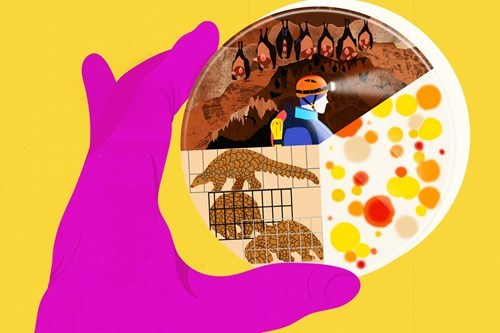
The authors, Shing Hei Zhan, Benjamin Deverman and Yujia Alina Chan, write: “We were surprised to find that SARS-CoV-2 exhibits low genetic diversity in contrast to SARS-CoV, which harbored considerable genetic diversity in its early-to-mid epidemic phase.” This implies, they argue, that “by the time SARS-CoV-2 was first detected in late 2019, it was already pre-adapted to human transmission to an extent similar to late epidemic SARS-CoV.” This is potentially very good news: Because the virus is relatively stable genetically, a vaccine that works against it, if we’re able to develop one, will be more likely to work against all strains.
The same study seems to rule out the possibility that infected animals at the Huanan Seafood Market in Wuhan transmitted the virus to several human beings, as some have suggested as a point of origin. The Chinese authorities have now confirmed that no animal samples from the market were infected. This suggests that a single person brought a virus that was already adept at human transmission to the market and infected others.
Work published in March by Andrew Rambaut of Edinburgh University, analyzing the genomic sequences, calculates that the most recent common ancestor of the viruses now in circulation infected someone in late November or early December, though with a “confidence range” stretching back into October. That leaves little time for evolutionary adaptation, so the months during which the virus fine-tuned its ability to infect human beings were presumably before this and somewhere other than the market in Wuhan.
The closest animal version of the virus remains a bat sample collected by scientists in 2013 a thousand miles away in Yunnan. Details of where and how that sample was collected have been sketchy, but a new paper by two scientists from the Agharkar Research Institute in Pune, India, show that it is the same as a published sample with a different name that was collected from an abandoned mineshaft in southern Yunnan in 2013, following an outbreak of pneumonia-like illness that killed three miners there the year before.
But that virus cannot be the immediate source of Covid-19. Part of one of its key genes, coding for the “spike” protein that allows the virus to lock onto human cells, is distinct from the version that is causing the pandemic. In the human virus, this part of the gene, called the “receptor binding motif,” more closely resembles the virus found in smuggled pangolins, though the rest of the pangolin virus is less similar.
Compared with the bat and pangolin viruses, the one now infecting human beings also has an extra 12-letter nucleotide sequence, called a “furin cleavage site,” in the spike protein gene; this greatly enhances the virus’s ability to get into and out of different types of human cells. Kristian Andersen of the Scripps Institute in La Jolla, Calif., and colleagues argue that this might have arisen by mutation during “a period of unrecognized transmission in humans” after the original transmission from an animal.
What about the controversial claim that the virus may have originated in a laboratory? Both Ralph Baric’s team at the University of North Carolina at Chapel Hill and Shi Zhengli’s team at the Wuhan Institute of Virology have been working on SARS-like coronaviruses and testing their ability to infect human cells. They have for some years reported successful experiments in which they created new strains of the virus by manipulating the spike proteins that are now the focus of discovering the origin of SARS-CoV-2, and their research has included inserting furin cleavage sites.
The two teams made these so-called chimeric viruses in order to understand what makes viruses more or less dangerous and in the hope of being ready to protect people against a future SARS epidemic. In 2015 they published a joint experiment in which they combined parts of one mouse-adapted SARS-like coronavirus with a spike gene from a SARS-like coronavirus derived from Chinese bats.
In reporting their results, they expressed caution about continuing such risky experiments: “On the basis of these findings, scientific review panels may deem similar studies building chimeric viruses based on circulating strains too risky to pursue, as increased pathogenicity in mammalian models cannot be excluded.” They added: “The potential to prepare for and mitigate future outbreaks must be weighed against the risk of creating more dangerous pathogens.”
Nikolai Petrovksy and colleagues at Flinders University in Australia have found that SARS-CoV-2 has a higher affinity for human receptors than for any other animal species they tested, including pangolins and horseshoe bats. He suggests that this could have happened if the virus was being cultured in human cells, adding that “We can’t exclude the possibility that this came from a laboratory experiment.”
So what did happen? At present, the evidence is pointing tentatively to a chain of person-to-person infections occurring somewhere outside a city before somebody brought the virus to Wuhan, where the market acted as an amplifier. The first case could have been a rural farmer or possibly a bat researcher collecting samples for virologists. Or it is possible that another animal was involved in some way, with the virus bouncing between a farmer and his animals, or a wildlife smuggler and his poor pangolins.
There are more coronaviruses out there. If the evidence is pointing away from wildlife markets, and if the Chinese authorities are confident it wasn’t a laboratory leak, they should be eager to help the world find out what did actually happen.
Whatever the initial spark, what turned a brush fire into a global conflagration was city life. Viruses have erupted into human beings from contact with nature many times in the past. When more of the population lived in rural areas, hunted animals for food and foraged in forests for firewood, contact with bats would have been more frequent. But chains of infection in rural villages would have petered out.
Today, all it takes is one infected individual to go to a crowded market and cough on somebody who is about to travel to another country, and the world catches the disease. It is sure to happen again.
To stay updated, follow me on Twitter @mattwridley and Facebook, or subscribe to my new newsletter!
My new book How Innovation Works is available now in the US and Canada, and available to pre-order in the UK.
May 30, 2020
A Wonderful and Innovative Two Weeks
I have taken a break from media appearances since Thursday—I needed a rest, and I'd say I like birds even more than innovation—but it was a wonderful first two weeks for me and for the book, thanks to you.
Here's an update on the launch, and what's planned for the coming weeks.
What Did You Think?

The feedback about the new book both on social media and from writers and business leaders I greatly respect—from Steven Pinker to Walter Isaacson to Richard Dawkins, from Naval Ravikant to James Altucher—has been both wonderful and somewhat humbling.
But now I want to hear from you! And I would like it if everyone else could, too.
As you can tell, I am working extra hard to promote this book compared to my last one: I think it could be the book that "saves" innovation, and I want it to reach as many people as possible. It's my understanding that the most effective way to promote a book is to encourage pre-orders (done, you pre-ordered over a thousand copies from Amazon.com alone) and to make sure it has a very successful first 3-5 weeks—hence why I have been saturating you with social media posts and newsletters recently, for better or worse!
I learned more recently that books with many reviews rank higher when readers search on Amazon: So if you want to help it be a successful book and spread our pro-freedom, pro-science and technology, pro-progress message, please consider ordering it now and if you already have, please consider giving it a quick review as soon as you're done. Afterwards, feel free to email me at mattwridley at gmail letting me know you did. I will share more on why below.
Early sales and reviews make all the difference, so please help me do some more marketing innovation, so that this paper plane can fly!
(If you're in the UK and confused why your copy hasn't shown up, it was delayed to 25th June, but has a special afterword added!)
Early Reviews
So far your Amazon reviews have all been very kind, as have those from publications that already reviewed it. Here are some highlights:
A fascinating theory of innovation, how it will shape the future and what makes it successful.
Scientific American
Quillette
An eye-opening book... a valiant attempt to change our understanding of human progress.
HumanProgress.org
Incredibly important and inspiring.
Capitalism Magazine
Thank you to all who have shared their thoughts online or elsewhere, or are planning to do so. I also have a review in a major business publication said to be coming early next week, so stay tuned for that.
Signed Copies, Zoom Meet Up
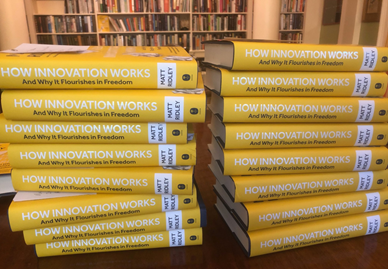
I would normally have signed hundreds of copies of my new book by now, already having done live events in NYC and DC, with more to come. This year, I could only sign sixteen—the publisher only gives you so many, and I have to pay and arrange to send them all personally—which shipped out yesterday.
14 are for regular fans who won our fun contests on social media and in the newsletter, one is for my marketing helper (and fan) whose idea the contest was, and only one is for a public figure: fellow biologist Richard Dawkins, one of my favourite writers and biggest influences, who was nice enough to say many kind things about it on Twitter (and let me know that I technically pronounced "compact" incorrectly).
Apologies to those who couldn't get one because of the pandemic, but I hope this will make them a little more special for those who did!
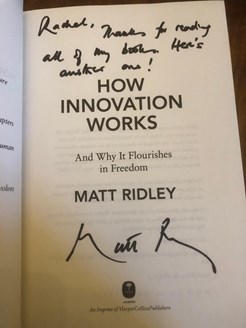
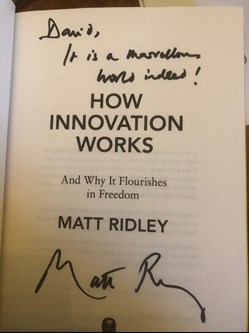
If you were told you won and are expecting a copy, feel free to email me at mattwridley at gmail to make certain we didn't overlook you. If you didn't win and you aren't in North America, we should have a contest for you coming up, too, so stay tuned here. If you're in North America and didn't win one, you will have to wait until there are live events again one day, but if you email me at mattwridley with an order confirmation or a selfie with the book by this weekend, as well as your address, I will have a signed bookplate sent to you for you to put on the cover, or your Kindle!
As another opportunity to encourage and interact with readers, soon I will be having a private Zoom meet up for those kind enough (or big enough fans) to have pre-ordered the book or ordered it in the first week. The tentative time is Monday the 8th of June at noon ET / 1700 BST, but this will be confirmed in the invite email. If you haven't received a Zoom invite, don't worry! One will go out early next week.
If you bought the book by the 23rd of May local time in North America, this is your last chance to send me confirmation and be added! If you've bought it since, or are planning to buy it soon, feel free to reply with your order confrmation, and we'll put you on the list of people to invite if there is extra space! And those who also reviewed it on Amazon will be put on the top of that list.
If you are in the United Kingdom or elsewhere in the world, there is still time to pre-order the book and officially get put on the list—but we will likely schedule second one in July for those outside North America. I'll let you know!
This will be a meet up, not a webinar. I want to give each of you a chance to speak and get to know you a bit. I can't wait to speak to some of my biggest fans personally, like I would get to at in-person book signing.
Upcoming Events
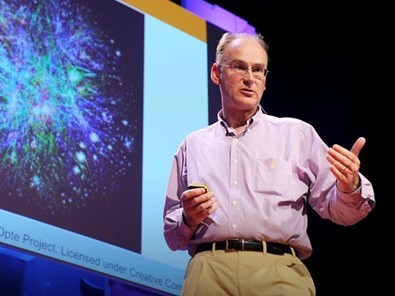
My "virtual book tour" will start up again next week as I try to go on "every single podcast" as one person on Twitter put it.
Here are a few highlights of what's already on the schedule:
Next Week: Power Hour with Alex Epstein
2nd June: How Innovation Works Interactive Book Forum with CEI
2nd June: Adam Smith Institute Covid-19 Webinar (Panelist)
Week of 8th June: The Yaron Brook Show
8th June: Zoom Meet Up (Tentative)
10th June: ConservativeHome Live Event with Mark Wallace
11th June: The Glenn Beck Program (Tentative)
Later in June: Dennis Prager
Later in June: A special to-be-announced and to-be-titled webinar focused on the pandemic, with an emphasis on Canada, hosted by the Institute for Liberal Studies
Thank you very much for your kind support.I hope you are enjoying my writing and appearances as much as I'm enjoying writing for and speaking to you.
To stay updated, follow me on Twitter @mattwridley and Facebook, or subscribe to my new newsletter!
My new book How Innovation Works is available now in the US and Canada, and available to pre-order in the UK.
May 25, 2020
The Solution to the Current Crises
My blog post for Human Progress:
When you think about it, what has happened to human society in the last 300 years is pretty weird. After trundling along with horses and sailboats, slaves and swords, for millennia, we suddenly got steam engines and search engines, and planes and cars and electricity and computers and social media and DNA sequences. We gave ourselves a perpetual motion machine called innovation. The more we innovated, the more innovation became possible.
It’s by far the biggest story of the last three centuries—the main cause of the decline of extreme poverty to unprecedented levels—yet we know curiously little about why it happened, let alone when and where and how it can be made to continue. It certainly did not start as a result of deliberate policy. Even today, beyond throwing money at scientists in the hope they might start businesses, and subsidies at businesses in the hope they might deliver products, we don’t have much of an idea how to encourage innovation at the political level.

What’s more, economists have been in a special muddle about innovation for a long time. The economics profession spent a couple of centuries assuming that markets tend towards equilibria, through the invisible hand. Hence John Stuart Mill and John Maynard Keynes and pretty well everybody else in between assumed that we would see diminishing returns come to dominate human endeavor. But instead we experienced increasing returns, accelerating invention. As the author David Warsh put it in his book Knowledge and the Wealth of Nations (2006) some years ago, economists obsessed about Adam Smith’s invisible hand but forgot about his pin factory, where specialization led to innovation.
Now, thanks to people like Nobel Prize winner Paul Romer, the penny has finally dropped that there is an effectively infinite number of ways to rearrange the atoms and bits in the world into useful combinations, and that returns can increase forever. At the same time, people have spotted that the societies that do the most innovating are the ones with the most freedom for people to exchange ideas. It was freedom, not state direction, that caused both Victorian Britain and modern California to be hotbeds of innovation. It was state dirigisme that prevented Stalin’s Russia, Mao’s China, Mugabe’s Zimbabwe and to a lesser extent Jean-Claude Juncker’s European Union from being similar hotbeds. Necessity is not the mother of invention. Ambition is.
In my new book How Innovation Works I argue that the state rarely deserves the credit for sparking innovation, in public health and elsewhere: “Far more often inventions and discoveries emerge by serendipity and the exchange of ideas, and are pushed, pulled, moulded, transformed and brought to life by people acting as individuals, firms, markets and yes, sometimes public servants. Trying to pretend that government is the main actor in this process, let alone one with directed intentionality, is an essentially creationist approach to an essentially evolutionary phenomenon.”
In a year marred by economic collapse and the worst pandemic in a century, it is more important than ever that we remember this lesson. Top-down, state organizations from the Chinese Communist Party to the World Health Organization to the Food and Drug Administration to Public Health England have repeatedly misled the public and strangled the experimentation and technological innovation needed to react to the COVID-19 outbreak, or to address the economic consequences of the pandemic.
From testing, to cures, to developing a vaccine, to creative and practical methods of physical distancing, the solution to the current crises is more innovation, not less.
That means more freedom, not less.
To stay updated, follow me on Twitter @mattwridley and Facebook, or subscribe to my new newsletter!
My new book How Innovation Works is available now in the US and Canada, and available to pre-order in the UK.
May 23, 2020
The growing evidence on vitamin D and Covid
My latest article for Spectator:
The argument that vitamin D deficiency may contribute to more severe cases of Covid is gaining ground. It is now reaching the point where it is surprising that we are not hearing from leading medical officials and politicians that people should consider taking supplements to ensure they have sufficient vitamin D.
This is not the same as arguing that vitamin D is a magic bullet that will cure the disease. Vitamins are not medication, the taking of which will have positive effects on everybody. They are top-ups: things that hurt you when you don’t have enough of them in your system but do no extra good when you have enough. Indeed, with many vitamins, including D, taking too much can be toxic.
However, it is true that many people are deficient in vitamin D, especially at the end of winter. That is because, uniquely, vitamin D is a substance manufactured by ultraviolet light falling on your skin. You can get some from fish and other foods, but not usually enough. So most people’s vitamin D levels fall to a low point in February or March when the sun has been weak and its UV output especially so. Public health bodies have long advised people to supplement vitamin D in winter anyway.
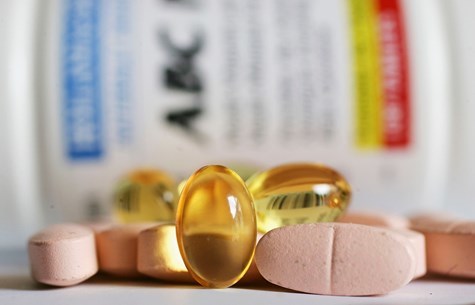
The level falls especially low in people who stay indoors a lot, including the elderly, and in those who have darker skin. Whereas the safe level of vitamin D is generally agreed to be above 10 nanograms per millilitre, one recent study of South Asians living in Manchester found average levels of 5.8 in winter and 9 in summer: too low at all times of the year. Darker skin reduces the impact of sunlight; so does the cultural habit of veiling; and so does a reluctance among some Muslims to take supplements that might have pork-derived gelatin in them.
Vitamin D deficiency has long been known to coincide with a greater frequency or severity of upper-respiratory tract infections, or colds. That this is a causal effect is supported by some studies showing that vitamin D supplements do reduce the risk of such infections. These studies are not without their statistical flaws, so cannot yet be regarded as certain, but they are not quackery like a lot of the stuff coming out of the supplements industry: they come from reputable medical scientists.
What about vitamin D and Covid in particular? Results are coming in from various settings and the main message seems to be that vitamin D deficiency may or may not help to prevent you catching the virus, but it does affect whether you get very ill from it. One recent study in Chicago concluded that its result 'argues strongly for a role of vitamin D deficiency in COVID-19 risk and for expanded population-level vitamin D treatment and testing and assessment of the effects of those interventions.'
The bottom line is that an elderly, overweight, dark-skinned person living in the north of England, in March, and sheltering indoors most of the time is almost certain to be significantly vitamin D deficient. If not taking supplements, he or she should be anyway, regardless of the protective effect against the Covid virus. Given that it might be helpful against the virus, should not this advice now be shouted from the rooftops?
A new article by a long list of medical experts in the BMJ cautiously agrees, confirming that many people in northern latitudes have poor vitamin D status, especially in winter or if confined indoors, and that low vitamin D status 'may be exacerbated during this COVID-19 crisis by indoor living and reduced sun exposure'.
It adds that very high intakes or 'mega supplements' will not help and may cause harm, and it is this that probably explains the reluctance of the authorities to spread the message. Another factor may be the lack of lobbying. Vitamin supplements are cheap and unpatented, so there is no great incentive for big companies to push them. All the more reason for government to do so.
It should be possible, and wise, to tell people to take modest doses of vitamin D supplements for their health. The evidence is easily strong enough to justify it.
To stay updated, follow me on Twitter @mattwridley and Facebook, or subscribe to my new newsletter!
My new book How Innovation Works is available now in the US and Canada, and available to pre-order in the UK.
May 20, 2020
My Latest Book, How Innovation Works, is Officially Available
I am delighted to be launching my new book How Innovation Works this week, which has officially arrived in the United States and Canada.
If you want to read it now, you can get the Kindle or audiobook (read by myself!) instantly.
But hardcover orders are even better! More on that below.
As always with a book, a year or two of writing and rewriting, plus many more years of thinking, comes down in the end to one day of releasing the finished book, as free of errors as possible, for anybody in the world to read and review, to like and loathe. It's like bringing up a baby eagle, then one day setting it free to soar high in the sky - or so I hope.
This one has been unusual, however, because of the Covid pandemic.
I would normally be in New York for the launch of the US edition getting ready to do a round of radio interviews and speeches and signing sessions. Instead I am trying to achieve the same thing locked down in my own home. I am growing hoarse from podcasting, and it often feels weird giving a talk to a blank screen, but I am getting great feedback from those who have read the book.
I think the topic is timely: innovation is what will defeat this virus, whether in vaccines, antiviral drugs or track-and-trace apps. The need to unleash innovation to defend humanity against future pandemics is clear, and the failure to do so enough in the past is worrying. It's evident too that innovation is a collaborative process which depends on the exchange of ideas, as I argue in the book, and whose benefits reach us all through the exchange of goods and services that we call trade.
The world really is all in this together.
Virtual North american Book Tour
Thank you for all the great questions on Facebook yesterday.
Thanks to all the recent innovations in communications and computing (see Ch. 6), my New York City launch event is happening tomorrow at noon despite the pandemic, and you don't have to be in New York or even America to come!
Over 300 people have signed up so far. Register now and join us: https://bit.ly/2WbJam3
Upcoming Live Appearances (ET)
Wednesday, 12:45pm: Streaming on Twitter for the first time ever
Thursday, Noon: Virtual Launch Event
Friday. Noon: Taking questions for my second reddit AMA ever
Additionally: Some time in the next two months I will be having an exclusive, interactive online event with people who ordered (or pre-ordered!) the hardcover of How Innovation Works in the first week, so if you did so, send proof of purchase to mattwridley at gmail ASAP and we'll reach out in a couple weeks!
Thank you as always for all of your help and support through this difficult time for everyone.
Speak soon!
To stay updated, follow me on Twitter @mattwridley and Facebook, or subscribe to my new newsletter!
My new book How Innovation Works is available now in the US and Canada, and available to pre-order in the UK.
May 18, 2020
Dithering officials are holding back the next wave of innovation
At the start of the pandemic, China built a hospital in double-quick time and we all thought, “that’s why they are so good at economic growth”. Then Britain did the same, proving we can do it too. Medical devices have been rushed through the approval process in days. Vaccine development is being brilliantly accelerated. We have shown we can do things quickly. Why can’t we do the same in ordinary times?
Like every small business owner, I find that quangos always take far, far longer than they need over decisions.
A local river trust cleaning out an old fish-pass on a river took several months to get approval from the Environment Agency; the work took one day. An attempt to turn derelict farm buildings into shops has so far taken local planning officials seven years to (not yet) decide.
Getting permission to extend a track by a hundred yards took Natural England many months of hesitation and several site visits.
The problem that faces firms up and down the country is not that regulators say no, but that they take an age to say yes. A local firm has been trying to start a project that would bring 200 good jobs and millions of pounds of tax revenue. It has been through planning permission, an inquiry, an appeal and a court case – winning at every stage. It was promised a ministerial decision last June and is still waiting, five years after applying.
From Heathrow Airport’s new runway to notifying you of a medical test result, everything seems to take far longer than necessary.
For private enterprise, time is money; delay can be lethal. Companies like Amazon, for all their faults, recognise this and promise you rapid delivery. For the public sector, there is no urgency. If the rules state that you must receive a reply within three weeks, then lo and behold, the reply arrives after three weeks, never two.
It can take up to six years to get a medical device – a new and faster diagnostic test for viruses, say – licensed in most European countries, including this one. Entrepreneurs cannot wait that long; their money runs out. We will never know how many innovations such delays have deterred, but they are surely one of the main reasons we were not better prepared for this pandemic.
To stay updated, follow me on Twitter @mattwridley and Facebook, or subscribe to my new newsletter!
My new book How Innovation Works is coming in May, and is available to pre-order in the UK, US, and Canada.
Innovation Can’t Be Forced, but It Can Be Quashed
My article for the Wall Street Journal Saturday Essay, adapted from How Innovation Works which is available Tuesday, the 19th of May:
The Covid-19 pandemic reveals that far from living in an age of incessant technological change, we have been neglecting innovation in exactly the areas where we most need it. Faced with a 17th-century plague, we are left to fall back mainly on the 17th-century response of quarantine and closing the theaters.
It is commonplace today to say that innovation is speeding up, but like much conventional wisdom, it is wrong. Some innovation is speeding up, certainly, but some is slowing down. Take speed itself. In my lifetime of more than sixty years, I have seen little or no improvement in the average speed of travel. Congestion on the roads and at airports has in many cases increased the scheduled travel time between two points. A modern airliner, with its high-bypass engines and less-swept wings, is designed to save fuel by going more slowly than a Boeing 707 did in the 1960s. The record for the fastest manned plane, 4,520 miles an hour, was set by the X-15 rocket plane in 1967 and remains unbroken. Boeing 747s are still flying half a century after they were launched. Concorde, the only supersonic passenger plane, is history.
Moreover, recent decades have seen innovation stalled or rejected in a number of technologies. Nuclear power has been unable to roll out plans for new reactor designs. Genetic modification of crops was effectively rejected by Europe. The flow of new pharmaceutical drugs has slowed to a trickle. Ride-sharing apps have been banned in many cities. As the investor Peter Thiel has pointed out, innovation is now largely a digital phenomenon, because bits are lightly regulated and atoms heavily regulated. On all sides we hear arguments that innovation threatens jobs, the environment, privacy and democracy.
Of immediate relevance to the current emergency, the development of vaccines has languished in the 21st century as an orphan technology, insufficiently encouraged by governments and ignored by the private sector. New vaccines are rarely profitable. By the time a company develops one for a new epidemic, the worst may be over. Last year Wayne Koff, president of the Human Vaccines Project, warned that the world was poorly prepared for a pandemic because vaccine development “is an expensive, slow and laborious process, costing billions of dollars, taking decades, with less than a 10% rate of success.”
It is not just vaccines. Throughout the economy, with the exception of the digital industry, the West is experiencing an innovation famine. The Austrian economist Joseph Schumpeter’s “perennial gale of creative destruction” has been replaced by the gentle breezes of rent-seeking. Two recent books argue that big companies in cozy cahoots with big government increasingly shy away from change, sheltered against competition by regulation and intellectual property rights. In “The Captured Economy” (2017), Brink Lindsey and Steven M. Teles make the case that to the extent that incomes have been stagnating and opportunities for social mobility drying up, the cause is not too much innovation but too little. In “The Innovation Illusion” (2016), Fredrik Erixon and Bjorn Weigel argue that Western economies have “developed a near obsession with precautions that simply cannot be married to a culture of experimentation.”
Innovation relies upon freedom to experiment and try new things, which requires sensible regulation that is permissive, encouraging and quick to give decisions. By far the surest way to rediscover rapid economic growth when the pandemic is over will be to study the regulatory delays and hurdles that have now been hastily swept aside to help innovators in medical devices and therapies, and to see whether such reforms could be applied to other parts of the economy too.
A big obstacle to innovation is the slow pace of regulatory licensing. One 2012 study found that a medical device takes around 21 months to get through the regulatory process in the U.S., from application to market, and 70 months in Germany. In the specific case of the Stratos implantable pacemaker, it took 14 months in the U.S., 40 months in France and 70 months in Italy.
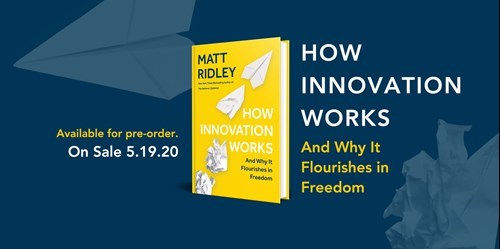 How Innovation Works is available to order now in the United States and Canada.
How Innovation Works is available to order now in the United States and Canada.
There is nothing new about resistance to innovation. In 1662, William Petty, a pioneering economist, medical professor and land speculator, lamented that “the poor inventor runs the gauntloop of all petulant wits,” with everybody trying to stop him from succeeding. At the time, King Charles II, lobbied by the brewing industry, was trying to ban a novel drink called coffee because it caused fake news. “As for coffee, tea and chocolate,” the king pronounced, “I know no good they do; only the places where they are sold are convenient for persons to meet in, sit half day and discourse with all companies that come in of State matters, talking of news and broaching of lies.”
Hansom cab operators in London furiously denounced the introduction of the umbrella for offering shelter to rain-soaked pedestrians. Margarine was subjected to a decadeslong smear campaign from the dairy industry. Musicians’ unions delayed the playing of recorded music on the radio. The Horse Association of America for many years fought a rear-guard action against the tractor, and the natural-ice harvesting industry frightened people with scares about the safety of refrigerators. You may laugh, but the same happens today: Incumbent vested interests, overcautious regulators, opportunistic activists and rent-seeking patent holders combine to oppose or delay almost every innovation.
Surprisingly, there is no good evidence that patents are helpful, let alone necessary, in encouraging innovation. A 2002 study by Josh Lerner, an economist at Harvard Business School, looked at 177 cases of strengthened patent policy in 60 countries over more than a century, finding that “these policy changes did not spur innovation.” James Watt, Samuel Morse, Guglielmo Marconi, the Wright brothers and many others wasted the best years of their lives in court defending their intellectual property, when they might have been busy developing new devices.
The expiration of patents often results in a burst of innovation, as with 3-D printing, where the recent lapse of three key patents has resulted in notable improvements in quality and a drop in price. The historian Anton Howes, of the Royal Society of Arts in London, points out that the French government bought out Louis Daguerre’s patent for photography in 1839 and made the technology freely available, unleashing a burst of creative innovation. Dr. Howes argues, “As we look to fight coronavirus and any future pandemics, we should perhaps consider which patents—for antivirals, vaccines, ventilators and other hygienic equipment—might be bought out in order to remove…innovation bottlenecks.”
What is innovation and how is it best encouraged? Policy makers tend to assume it is the result of clever people having clever thoughts in ivory towers. But science is just as often the fruit as the seed of technology, and invention is different from innovation. To illustrate the difference, Charles Townes, who won the Nobel Prize for the physics behind the laser in 1964, was fond of telling the story of a beaver and a rabbit looking up at the Hoover Dam. “No, I didn’t build it myself,” says the beaver. “But it’s based on an idea of mine.” Discoverers and inventors often feel they get too little credit or profit from a good idea, forgetting just how much effort was needed to turn that idea into a workable, affordable innovation that actually delivered benefits to people.
Thomas Edison understood better than anybody that trial and error is the key to turning an invention into a useful innovation. In developing the nickel-iron battery, his employees undertook 50,000 experiments. Developing a new technology, he famously said, is 1% inspiration and 99% perspiration. Jeff Bezos makes the same point: “Being wrong might hurt you a bit, but being slow will kill you. If you can increase the number of experiments you try from a hundred to a thousand, you dramatically increase the number of innovations you produce.” It turns out that continuous tinkering to develop and refine a better product is much more important than protecting what you’ve already created.
Far from sudden “eureka” moments, innovation is nearly always a gradual process that proceeds by incremental steps. It is a team sport: There is no individual who can be credited with inventing the computer or the internet. The introduction of short-strawed wheat that revolutionized Asian agriculture in the 1960s, resulting in the defeat of famine, was driven by Manzoor Bajwa in Pakistan and M.S. Swaminathan in India. But they got the idea from Norman Borlaug in Mexico, who got it from Burton Bayles, who got it from Orville Vogel, who got it from Cecil Salmon, who got it from Gonjirô Inazuka in Japan, who got it from…at this point the trail runs cold.
Once started, innovation is so inexorable it looks inevitable: 21 different people had the idea of the lightbulb independently. Many people besides the Google founders came up with search engines in the 1990s. Yet, paradoxically, innovation is impossible to predict. Almost nobody foresaw the usefulness and profitability of search engines. The first half of the 20th century brought dramatic changes in transport, the second half in communication. The switch was not the result of policy: Innovation cannot easily be forced.
Given this unpredictability, politicians should rethink the incentives for innovation. One option is to expand the use of prizes, to replace reliance on grants, subsidies and patents. Britain’s famous Longitude Prize, offered in 1714 for accurately measuring longitude at sea, elicited a solution from an unexpected direction: accurate and robust clocks made by a humble clockmaker, John Harrison. Similar serendipity happens today. One study of the online problem-sharing forum known as Innocentive, where organizations can reward crowdsourced solutions to problems that baffle them, found that “the further the focal problem was from the solvers’ field of expertise, the more likely they were to solve it.” Teflon, Kevlar and the Post-it Note are all examples of useful things developed by people looking for something completely different.
The Nobel Prize-winning economist Michael Kremer came up with a concept called the Advance Market Commitment that would fine-tune prizes as incentives to innovate. In 2007, the Gates Foundation committed $1.5 billion to a prize fund to find a vaccine for Pneumococcus bacteria for use in developing countries, where no pharmaceutical company could make money from it. But rather than just winning a lump sum for meeting the goal, companies were assured that if they succeeded, they would win a contract that paid out for 10 years at a good price. The prize money effectively topped up the sum received by the pharmaceutical firm for every vaccine sold. The result of the auction was three good vaccines, costing $2 per dose, which have been given to 150 million children, saving 700,000 lives.
The world would benefit from more innovation, and it need not be high-tech. Consider just one remarkable development that has saved millions of lives from malaria in recent decades: the insecticide-treated mosquito net.
In June 1983, in the West African country of Burkina Faso, a group of French and Vietnamese scientists together with African colleagues began an experiment. They installed mosquito nets in 36 huts specially equipped with mosquito traps. Half the nets were treated with the insecticide permethrin and half had holes torn in them to simulate the wear and tear of everyday life. For five months, volunteers slept in the huts, while every mosquito that entered or tried to leave the huts was collected, dead or alive. The results showed that the presence of a permethrin-treated net, whether intact or torn, repelled mosquitoes, reducing the number entering the huts by about 70% and increasing the rate at which the insects left the hut from 25% to 97%.
This simple, careful experiment proved to be a breakthrough in the control of malaria in Africa. Supported by the Gates Foundation, impregnated bednets first started to be used on a wide scale in 2003, and that very year malaria mortality began to decline. According to a recent study in the journal Nature, insecticide-treated mosquito nets account for 70% of the six million lives saved world-wide from malaria in recent years, twice as high a percentage as antimalarial drugs and insecticide sprays put together. Globally, the death rate from malaria has halved since 2003.
Dealing with Covid-19 has forcibly reminded governments of the value of innovation. But if we are to get faster vaccines and treatments—and better still, more innovation across all fields in the future—then innovators need to be freed from the shackles that hold them back.
To stay updated, follow me on Twitter @mattwridley and Facebook, or subscribe to my new newsletter!
My new book How Innovation Works is coming in May, and is available to pre-order in the UK, US, and Canada.
May 14, 2020
23 of Your AMA Questions, Answered
Last week, I did an AMA with a community called whatshouldireadnext.com and the answers are now available on their blog.
I answered 23 questions in total from their community and staff as well as a few from social media, discussing the usual topics of innovation and the pandemic, but also some new ones like time management, murder hornets, and what the Earth might be like in one hundred or a thousand years. Here are some highlights:
In response to COVID-19, it is assumed that there will be a number of innovations: a new way of working, medical devices, new drugs, and new technology. What is the new innovation you are most interested in the post COVID world?
The thing that most surprised me about this episode was realising how slow vaccine development still is. The big prize would be much faster and more oven-ready vaccines for viruses. But I suspect antiviral drugs will make big strides during this pandemic too as they did during ebola. And hand-held, instant DNA PCR testing kits will surely become a big part of the world's preparedness.
Do you believe that with our human collective brain, our marketplace of ideas sprouting from specialized individuals, that there is a limit to how much we can innovate and circumvent any hardship? Is there a utopia waiting for us, or a cyberpunk version of our society like we see so much in various media?
I see no limit to potential innovation. Not even a theoretical one. Because innovation means rearranging atoms or bits of information is useful ways and there are infinite ways of doing this. Futuristic visions are often dystopian, but I think that's a mistake. Can you recall any Hollywood film in which the future is portrayed positively?
Matt, you're a world-famous biologist and have written extensively about threats like Coronavirus. Why have you refused to address the incoming Murder Hornet disaster? Do you agree with me that Coronavirus is just a distraction from Murder Hornets? And are you in the pockets of Big Hornet?
Ha! I keep seeing the phrase murder hornet, but being in the UK I have not read any stories so I know nothing! This is an insect, right? Where has it come from and why is it a murderer. Is it like a killer bee only bigger? Here in Europe, we are supposed to be scared of Japanese hornets apparently. But you're right - I am being paid by a big hornet.
May 12, 2020
Contest: Win a Free Signed Copy of How Innovation Works
With the North America release of How Innovation Works just one week away, I am unable to travel to the US to promote the book as I would normally do. So my team and I are trying to come up with creative ways to promote the book while also sharing free content and prizes with you.
When books are released, those who have helped me write the book as well as press and other insiders get free, often signed copies. We thought regular readers should have a chance to get one themselves, especially with live events being impossible right now.
So we decided to give away at least ten free signed copies of How Innovation Works to fans in the US and Canada.
In fact, I recently signed over one hundred labels to mail to the US publisher to put on review copies and other copies for media and influencers. So this year, these ten fans will be among the very few to get a directly signed copy!
There are three ways to enter the drawing:
Share this Facebook post (while liking my page)
Retweet this tweet (while following me)
Email my team at mattwridley at gmail (de-formatted to prevent spam bots) with "How Innovation Works" in the subject, and attach proof that you pre-ordered the book—whether an Amazon order confirmation, an order confirmation from another seller, or just a photo of a physical receipt—to be entered three times!
You are allowed to enter each way, so by doing each one, you’ll have 5X the odds of winning.
Some time this weekend, before 11:59 PM BST on the 17th, my team will randomly select ten entries as winners and reach out to you for shipping information.
The copies unfortunately most likely won’t arrive for several weeks, as I will be shipping them from England myself, so to read the book next week you’ll still want to purchase it (and perhaps give the first copy to a friend if you win). But people who don’t order it are still free to enter via Facebook and Twitter for a chance to get it without buying it at all.
While this is only available to fans in North America, readers in the UK and possibly elsewhere will have their own contest closer to their local release date.
Thank you so much for your continued support during this difficult time. I look forward to sharing more content and events with you in the coming months!
To stay updated, follow me on Twitter @mattwridley and Facebook, or subscribe to my new newsletter!
My new book How Innovation Works is coming in May, and is available to pre-order in the UK, US, and Canada.
Matt Ridley's Blog
- Matt Ridley's profile
- 2180 followers


